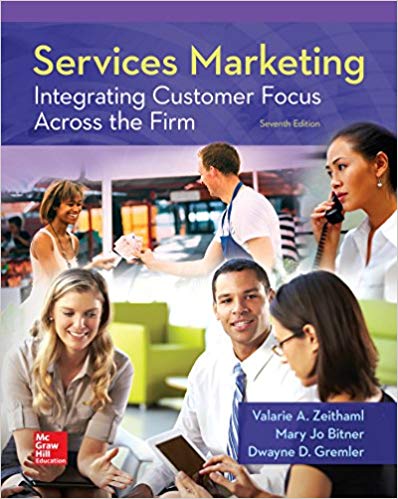This is completed downloadable of Test Bank for Services Marketing: Integrating Customer Focus Across the Firm 7th Edition

Product Details:
- ISBN-10 : 0078112109
- ISBN-13 : 978-0078112102
- Author: Valarie A. Zeithaml, Mary Jo Bitner, Dwayne Gremler
Zeithaml’s Services Marketing introduces readers to the vital role that services play in the economy and its future. Services dominate the advanced economies of the world, and virtually all companies view services as critical to retaining their customers. The seventh edition maintains a managerial focus by incorporating company examples and strategies for addressing issues in every chapter, emphasizing the knowledge needed to implement service strategies for competitive advantage across industries.
New research references and examples in every chapter include increased coverage of new business model examples such as Airbnb, Uber, OpenTable, Mint/Intuit, and others, alongside greater emphasis on technology, digital and social marketing, Big Data, and data analytics as a service. The longer cases have been removed from the 7e. View Table of Contents and Features below for more information.
Table of Content:
- Cover
- Title
- Copyright
- About the Authors
- Preface
- Brief Contents
- Detailed Contents
- PART 1 FOUNDATIONS FOR SERVICE MARKETING
- Chapter 1 Introduction to Services
- What are Services?
- Service Industries, Service as a Product, Customer Service, and Derived Service
- Tangibility Spectrum
- Trends in the Service Sector
- Why Service Marketing?
- Service-Based Economies
- Service as a Business Imperative in Goods-Focused Businesses
- Deregulated Industries and Professional Service Needs
- Service Marketing Is Different
- Service Equals Profits
- Exhibit 1.1: Is the Marketing of Services Different? A Historical Perspective
- But “Service Stinks”
- Strategy Insight: Competing Strategically through Service
- Service and Technology
- Technology-Based Service Offerings
- New Ways to Deliver Service
- Technology Spotlight: The Changing Face of Customer Service
- Enabling Both Customers and Employees
- Extending the Global Reach of Services
- The Internet Is a Service
- Global Feature: The Migration of Service Jobs
- The Paradoxes and Dark Side of Technology and Service
- Characteristics of Services
- Intangibility
- Heterogeneity
- Simultaneous Production and Consumption
- Perishability
- Search, Experience, and Credence Qualities
- Challenges and Questions for Service Marketers
- Service Marketing Mix
- Traditional Marketing Mix
- Expanded Mix for Services
- Staying Focused on the Customer
- Exhibit 1.2: Southwest Airlines: Aligning People, Processes, and Physical Evidence
- Summary
- Discussion Questions
- Exercises
- Notes
- Chapter 2 Conceptual Framework of the Book: The Gaps Model of Service Quality
- The Customer Gap
- The Provider Gaps
- Provider Gap 1: the Listening Gap
- Provider Gap 2: the Service Design and Standards Gap
- Global Feature: An International Retailer Puts Customers in the Wish Mode to Begin Closing the Gaps
- Provider Gap 3: the Service Performance Gap
- Technology Spotlight: Technology’s Critical Impact on the Gaps Model of Service Quality
- Provider Gap 4: the Communication Gap
- Putting It All Together: Closing the Gaps
- Strategy Insight: Using the Gaps Model to Assess an Organization’s Service Strategy
- Summary
- Discussion Questions
- Exercises
- Notes
- PART 2 FOCUS ON THE CUSTOMER
- Chapter 3 Customer Expectations of Service
- Service Expectations
- Types of Expectations
- Global Feature: Global Outsourcing of Personal Services: What Are Customers’ Expectations?
- The Zone of Tolerance
- Factors that Influence Customer Expectations of Service
- Sources of Desired Service Expectations
- Technology Spotlight: Customer Expectations of Airport Services Using Technology
- Sources of Adequate Service Expectations
- Sources of Both Desired and Predicted Service Expectations
- Strategy Insight: How Service Marketers Can Influence Customers’ Expectations
- Issues Involving Customers’ Service Expectations
- What Does a Service Marketer Do if Customer Expectations Are “Unrealistic”?
- Exhibit 3.1: Service Customers Want the Basics
- Should a Company Try to Delight the Customer?
- How Does a Company Exceed Customer Service Expectations?
- Do Customers’ Service Expectations Continually Escalate?
- How Does a Service Company Stay Ahead of Competition in Meeting Customer Expectations?
- Summary
- Discussion Questions
- Exercises
- Notes
- Chapter 4 Customer Perceptions of Service
- Customer Perceptions
- Satisfaction versus Service Quality
- Transaction versus Cumulative Perceptions
- Customer Satisfaction
- What Is Customer Satisfaction?
- What Determines Customer Satisfaction?
- National Customer Satisfaction Indexes
- The American Customer Satisfaction Index
- Outcomes of Customer Satisfaction
- Service Quality
- Outcome, Interaction, and Physical Environment Quality
- Service Quality Dimensions
- Global Feature: Differences in Service Quality Perceptions and Customer Rage Across Cultures
- E-Service Quality
- Customer Effort
- Service Encounters: The Building Blocks for Customer Perceptions
- Strategy Insight: Customer Satisfaction and the Bottom Line
- Service Encounters or Moments of Truth
- The Importance of Encounters
- Exhibit 4.1: One Critical Encounter Destroys a 30-Year Relationship
- Types of Service Encounters
- Sources of Pleasure and Displeasure in Service Encounters
- Technology Spotlight: Customers Love Amazon
- Technology-Based Service Encounters
- Summary
- Discussion Questions
- Exercises
- Notes
- PART 3 UNDERSTANDING CUSTOMER REQUIREMENTS
- Chapter 5 Listening to Customers through Research
- Using Customer Research to Understand Customer Expectations
- Research Objectives for Services
- Criteria for an Effective Service Research Program
- Exhibit 5.1: Elements in an Effective Customer Research Program for Services
- Elements in an Effective Service Marketing Research Program
- Complaint Solicitation
- Technology Spotlight: Conducting Customer Research on the Web
- Critical Incident Studies
- Requirements Research
- Relationship and SERVQUAL Surveys
- Exhibit 5.2: SERVQUAL: A Multidimensional Scale to Capture Customer Perceptions and Expectations of Service Quality
- Trailer Calls or Posttransaction Surveys
- Service Expectation Meetings and Reviews
- Process Checkpoint Evaluations
- Market-Oriented Ethnography
- Mystery Shopping
- Customer Panels
- Lost Customer Research
- Future Expectations Research
- Analyzing and Interpreting Customer Research Findings
- Strategy Insight: Big Data Provides New Tools to Research Consumers
- Global Feature: Conducting Customer Research in Emerging Markets
- Customer Journey and Experience Maps
- Importance/Performance Matrices
- Using Marketing Research Information
- Upward Communication
- Objectives for Upward Communication
- Exhibit 5.3: Elements in an Effective Program of Upward Communication
- Research for Upward Communication
- Exhibit 5.4: Employees Provide Upward Communication at Cabela’s, “World’s Foremost Outfitter”
- Benefits of Upward Communication
- Summary
- Discussion Questions
- Exercises
- Notes
- Chapter 6 Building Customer Relationships
- Relationship Marketing
- The Evolution of Customer Relationships
- Exhibit 6.1: A Typology of Exchange Relationships
- The Goal of Relationship Marketing
- Technology Spotlight: Customer Information Systems Help Enhance the Customer Relationship
- Benefits for Customers and Firms
- Relationship Value of Customers
- Exhibit 6.2: Calculating the Relationship Value of an Intuit Customer
- Customer Profitability Segments
- Profitability Tiers—the Customer Pyramid
- The Customer’s View of Profitability Tiers
- Making Business Decisions Using Profitability Tiers
- Relationship Development Strategies
- Core Service Provision
- Switching Barriers
- Relationship Bonds
- Global Feature: Developing Loyal Customers at Airbnb
- Relationship Challenges
- The Customer Is Not Always Right
- Strategy Insight: “The Customer Is Always Right”: Rethinking an Old Tenet
- Ending Business Relationships
- Summary
- Discussion Questions
- Exercises
- Notes
- Chapter 7 Service Recovery
- The Impact of Service Failure and Recovery
- Service Recovery Effects
- Exhibit 7.1: The Service Recovery Paradox
- How Customers Respond to Service Failures
- Why People Do (and Do Not) Complain
- Exhibit 7.2: The Internet Spreads the Story of Poor Service Recovery: “United Breaks Guitars”
- Types of Customer Complaint Actions
- Types of Complainers
- Service Recovery Strategies: Fixing the Customer
- Respond Quickly
- Exhibit 7.3: Service Hero Stories
- Provide Appropriate Communication
- Technology Spotlight: Cisco Systems—Customers Recover for Themselves
- Treat Customers Fairly
- Exhibit 7.4: Fairness Themes in Service Recovery
- Global Feature: Service Recovery across Cultures
- Cultivate Relationships with Customers
- Service Recovery Strategies: Fixing the Problem
- Encourage and Track Complaints
- Learn from Recovery Experiences
- Strategy Insight: Eliciting Complaints and Reports of Service Failure
- Learn from Lost Customers
- Make the Service Fail-Safe—Do It Right the First Time!
- Service Guarantees
- Characteristics of Effective Guarantees
- Types of Service Guarantees
- Benefits of Service Guarantees
- When to Use (or Not Use) a Guarantee
- Exhibit 7.5: Questions to Consider in Implementing a Service Guarantee
- Switching Versus Staying Following Service Recovery
- Summary
- Discussion Questions
- Exercises
- Notes
- PART 4 ALIGNING SERVICE DESIGN AND STANDARDS
- Chapter 8 Service Innovation and Design
- Challenges of Service Innovation and Design
- Important Considerations for Service Innovation
- Involve Customers and Employees
- Global Feature: The Global Service Innovation Imperative
- Employ Service Design Thinking and Techniques
- Technology Spotlight: Facebook: A Radical Service Innovation
- Types of Service Innovation
- Service Offering Innovation
- Innovating around Customer Roles
- Innovation through Service Solutions
- Service Innovation through Interconnected Products
- Exhibit 8.1: Pills with Sensors Track Drug Usage by Patients
- Stages in Service Innovation and Development
- Front-End Planning
- Strategy Insight: Strategic Growth through Services
- Implementation
- Exhibit 8.2: Service Innovation at the Mayo Clinic
- Service Blueprinting: A Technique for Service Innovation and Design
- What Is a Service Blueprint?
- Blueprint Components
- Service Blueprint Examples
- Blueprints for Technology-Delivered Self-Service
- Reading and Using Service Blueprints
- Building a Blueprint
- Exhibit 8.3: Blueprinting in Action at ARAMARK Parks and Destinations
- Exhibit 8.4: Frequently Asked Questions about Service Blueprinting
- Summary
- Discussion Questions
- Exercises
- Notes
- Chapter 9 Customer-Defined Service Standards
- Factors Necessary for Appropriate Service Standards
- Standardization of Service Behaviors and Actions
- Formal Service Targets and Goals
- Strategy Insight: Using Big Data to Define Service Standards and Improve Customer Experience
- Customer-, Not Company-, Defined Standards
- Types of Customer-Defined Service Standards
- Hard Customer-Defined Standards
- Exhibit 9.1: Examples of Hard Customer-Defined Standards
- Soft Customer-Defined Standards
- One-Time Fixes
- Global Feature: Adjusting Service Standards around the Globe
- Exhibit 9.2: Examples of Soft Customer-Defined Standards
- Development of Customer-Defined Service Standards
- Turning Customer Requirements into Specific Behaviors and Actions
- Exhibit 9.3: Hard and Soft Standards for Service at Ford Motor Company
- Exhibit 9.4: Expected Behaviors for Service Encounters at John Robert’s Spa
- Technology Spotlight The Power of Good Responsiveness Standards
- Developing Service Performance Indexes
- Summary
- Discussion Questions
- Exercises
- Notes
- Chapter 10 Physical Evidence and the Servicescape
- Physical Evidence
- What Is Physical Evidence?
- Technology Spotlight: Virtual Servicescapes: Experiencing Services through the Internet
- How Does Physical Evidence Affect the Customer Experience?
- Types of Servicescapes
- Servicescape Usage
- Servicescape Complexity
- Strategic Roles of the Servicescape
- Package
- Facilitator
- Strategy Insight: Strategic Positioning through Architectural Design
- Socializer
- Differentiator
- Framework for Understanding Servicescape Effects on Behavior
- The Underlying Framework
- Behaviors in the Servicescape
- Exhibit 10.1: Servicescapes and Well-Being in Health Care
- Exhibit 10.2: Social Support in “Third Places”
- Internal Responses to the Servicescape
- Environmental Dimensions of the Servicescape
- Exhibit 10.3: Designing the Mayo Clinic Hospital
- Global Feature: McDonald’s Adapts Servicescapes to Fit the Culture
- Guidelines for Physical Evidence Strategy
- Recognize the Strategic Impact of Physical Evidence
- Blueprint the Physical Evidence of Service
- Clarify Strategic Roles of the Servicescape
- Assess and Identify Physical Evidence Opportunities
- Update and Modernize the Evidence
- Work Cross-Functionally
- Summary
- Discussion Questions
- Exercises
- Notes
- PART 5 DELIVERING AND PERFORMING SERVICE
- Chapter 11 Employees’ Roles in Service
- Service Culture
- Exhibiting Service Leadership
- Developing a Service Culture
- Global Feature: How Well Does a Company’s Service Culture Travel?
- Transporting a Service Culture
- The Critical Role of Service Employees
- The Service Triangle
- Employee Satisfaction, Customer Satisfaction, and Profits
- The Effect of Employee Behaviors on Service Quality Dimensions
- Boundary-Spanning Roles
- Emotional Labor
- Sources of Conflict
- Strategy Insight: Strategies for Managing Emotional Labor
- Quality/Productivity Trade-Offs
- Strategies for Delivering Service Quality Through People
- Hire the Right People
- Technology Spotlight: How Technology Is Helping Employees Serve Customers More Effectively and Efficiently
- Exhibit 11.1: Google Quickly Becomes a Preferred Employer in Its Industry
- Develop People to Deliver Service Quality
- Exhibit 11.2: Potential Benefits and Costs of Empowerment
- Provide Needed Support Systems
- Retain the Best People
- Customer-Oriented Service Delivery
- Summary
- Discussion Questions
- Exercises
- Notes
- Chapter 12 Customers’ Roles in Service
- The Importance of Customers in Service Cocreation
- Customers Themselves
- Strategy Insight: Customer Cocreation of Value: An Important Strategy Frontier
- Fellow Customers
- Exhibit 12.1: Client Cocreation of Value in Business-to-Business Services
- Customers’ Roles
- Customers as Productive Resources
- Customers as Contributors to Quality, Satisfaction, and Value
- Exhibit 12.2: Which Customer (A or B) Will Be Most Satisfied?
- Global Feature: At Sweden’s IKEA, Customers around the World Cocreate Customized Value
- Customers as Competitors
- Self-Service Technologies—The Ultimate in Customer Participation
- A Proliferation of New SSTs
- Customer Usage of SSTs
- Success with SSTs
- Strategies for Enhancing Customer Participation
- Define Customers’ Roles
- Technology Spotlight: Technology Facilitates Customer Participation in Health Care
- Recruit, Educate, and Reward Customers
- Exhibit 12.3: Working Together, U.S. Utility Companies and Customers Conserve Energy
- Exhibit 12.4: Weight Watchers Educates and Orients New Members
- Manage the Customer Mix
- Summary
- Discussion Questions
- Exercises
- Notes
- Chapter 13 Managing Demand and Capacity
- The Underlying Issue: Lack of Inventory Capability
- Capacity Constraints
- Time, Labor, Equipment, and Facilities
- Optimal versus Maximum Use of Capacity
- Demand Patterns
- The Charting of Demand Patterns
- Predictable Cycles
- Random Demand Fluctuations
- Demand Patterns by Market Segment
- Strategies for Matching Capacity and Demand
- Shifting Demand to Match Capacity
- Global Feature: Cemex Creatively Manages Chaotic Demand for Its Services
- Adjusting Capacity to Meet Demand
- Combining Demand and Capacity Strategies
- Strategy Insight: Combining Demand (Marketing) and Capacity (Operations) Strategies to Increase Profits
- Yield Management: Balancing Capacity Utilization, Pricing, Market Segmentation, and Financial Return
- Implementing a Yield Management System
- Exhibit 13.1: Simple Yield Calculations: Examples from Hotel and Legal Services
- Technology Spotlight: Information and Technology Drive Yield Management Systems
- Challenges and Risks in Using Yield Management
- Waiting Line Strategies: When Demand and Capacity Cannot be Matched
- Employ Operational Logic
- Exhibit 13.2: Overflow in the ED: Managing Capacity Constraints and Excess Demand in Hospital Emergency Departments
- Establish a Reservation Process
- Differentiate Waiting Customers
- Make Waiting More Pleasurable
- Summary
- Discussion Questions
- Exercises
- Notes
- PART 6 MANAGING SERVICE PROMISES
- Chapter 14 Integrated Service Marketing Communications
- The Need for Coordination in Marketing Communication
- Key Service Communication Challenges
- Service Intangibility
- Management of Service Promises
- Management of Customer Expectations
- Customer Education
- Internal Marketing Communication
- Five Categories of Strategies to Match Service Promises with Delivery
- Address Service Intangibility
- Strategy Insight: Mobile Advertising—The Key to the Future of Digital
- Exhibit 14.1: Service Advertising Strategies Matched with Properties of Intangibility
- Manage Service Promises
- Global Feature: Virgin Atlantic Airways
- Technology Spotlight: Internet Expert Mary Meeker Predicts What Companies Most Need to Know
- Manage Customer Expectations
- Manage Customer Education
- Manage Internal Marketing Communication
- Summary
- Discussion Questions
- Exercises
- Notes
- Chapter 15 Pricing of Services
- Three Key Ways that Service Prices are Different for Customers
- Customer Knowledge of Service Prices
- Exhibit 15.1: What Do You Know about the Prices of Services?
- The Role of Nonmonetary Costs
- Price as an Indicator of Service Quality
- Approaches to Pricing Services
- Cost-Based Pricing
- Competition-Based Pricing
- Strategy Insight: Pricing Variation in Airlines Offers Strategic Opportunities
- Demand-Based Pricing
- Global Feature: Unique Tipping and Pricing Practices around the World
- Technology Spotlight: Dynamic Pricing on the Internet Allows Price Adjustments Based on Supply and Demand
- Pricing Strategies That Link to the Four Value Definitions
- Exhibit 15.2: Pricing for Customer-Perceived Value with Modular Service Pricing and Service Tiering
- Pricing Strategies When the Customer Means “Value Is Low Price”
- Pricing Strategies When the Customer Means “Value Is Everything I Want in a Service”
- Pricing Strategies When the Customer Means “Value Is the Quality I Get for the Price I Pay”
- Pricing Strategies When the Customer Means “Value Is All That I Get for All That I Give”
- Summary
- Discussion Questions
- Exercises
- Notes
- PART 7 SERVICE AND THE BOTTOM LINE
- Chapter 16 The Financial and Economic Impact of Service
- Service and Profitability: The Direct Relationship
- Exhibit 16.1: Customer Satisfaction, Service Quality, and Firm Performance
- Offensive Marketing Effects of Service: Attracting More and Better Customers
- Defensive Marketing Effects of Service: Customer Retention
- Lower Costs
- Volume of Purchases
- Price Premium
- Word-of-Mouth Communication
- Exhibit 16.2: Word-of-Mouth Communication and Customer Measurement: The Net Promoter Score
- Customer Perceptions of Service Quality and Purchase Intentions
- Exhibit 16.3: Questions That Managers Want Answered about Defensive Marketing
- Exhibit 16.4: Service Quality and the Economic Worth of Customers: Businesses Still Need to Know More
- The Key Drivers of Service Quality, Customer Retention, and Profits
- Effective Nonfinancial Performance Measurements
- Strategy Insight: Customer Equity and Return on Marketing: Metrics to Match a Strategic Customer-Centered View of the Firm
- Technology Spotlight: Cost-Effective Service Excellence through Technology
- Global Feature: Measurement of Customer Satisfaction Worldwide
- Summary
- Discussion Questions
- Exercises
- Notes
- Index
People Also Search:
services marketing integrating customer focus across the firm
services marketing: integrating customer focus across the firm 7th edition
services marketing integrating customer focus across the firm 7th edition test bank download pdf
services marketing integrating customer focus across the firm 7th edition download scribd





